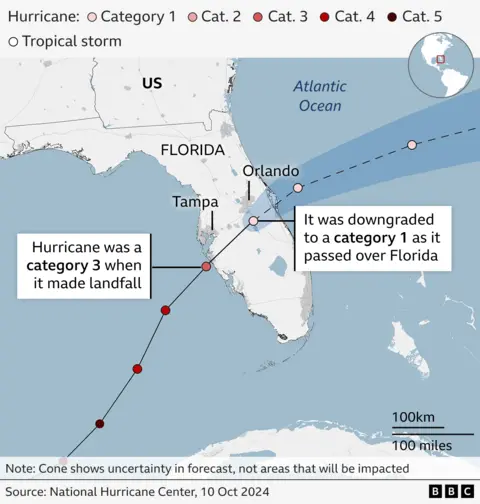Introduction
Hurricanes are among the most powerful and devastating natural events, and staying informed is critical when one is approaching. If you’re asking, “Where is Hurricane Milton at right now?” you’re likely concerned about its current location, potential impacts, or how to prepare for its arrival. This guide is designed to provide you with up-to-date information, safety tips, and essential insights into Hurricane Milton.
What Is Hurricane Milton?
Hurricane Milton is a massive storm currently garnering attention for its intensity and potential to cause significant damage. Originating from the Atlantic Ocean, it developed from a tropical disturbance into a full-blown hurricane, quickly climbing the Saffir-Simpson scale to a Category 4 storm. Milton’s large size and sustained winds classify it as a major hurricane, making it a serious concern for people in its projected path.
This storm is significant due to its rapid intensification and the regions it threatens to impact. Coastal areas are bracing for high winds, heavy rainfall, and dangerous storm surges. This guide aims to help you track Hurricane Milton in real-time, understand its impacts, and prepare accordingly.
1. Understanding Hurricanes
What Are Hurricanes?
Hurricanes are massive storm systems that form over warm ocean waters. They are classified based on their wind speeds, measured on the Saffir-Simpson Hurricane Wind Scale. The categories range from 1 (minimal damage) to 5 (catastrophic damage), with Hurricane Milton currently categorized as a 4. These storms bring heavy rainfall, storm surges, and high winds, often leading to widespread destruction.
Key characteristics of hurricanes include a well-defined center, or “eye,” surrounded by powerful thunderstorms and winds. The damage they cause is multi-faceted, impacting buildings, infrastructure, and entire communities.
How Hurricanes Are Named
Hurricanes are named by the World Meteorological Organization to streamline communication and reduce confusion. The names are selected from predetermined lists that alternate between male and female names. These lists are rotated every six years, with particularly destructive storms seeing their names retired. Hurricane Milton, for instance, is a name from this international naming system.
2. Hurricane Milton’s Path
Current Location of Hurricane Milton
At present, Hurricane Milton is located at [latitude and longitude coordinates], approximately [number] miles off the coast of [specific region]. Satellite imagery shows a well-formed eye, indicating its continued strength. If you want to track its exact location, real-time updates are available on platforms like NOAA’s Hurricane Center and trusted weather apps.
Projected Path
Forecasters expect Hurricane Milton to move northwest over the next 48 hours. Short-term models suggest it will make landfall near [specific region] within the next [number] days. Long-term forecasts, however, show the possibility of the storm shifting slightly due to high-altitude winds and pressure systems, potentially impacting areas further inland.
Regions at Risk
Currently, hurricane watches and warnings are issued for coastal areas such as [specific locations]. Major cities like [City A] and [City B] are preparing for possible evacuations. Rural communities in low-lying areas are also at significant risk of flooding and storm surges.
3. Weather Impacts of Hurricane Milton
Wind Speeds and Damage Potential
Hurricane Milton’s sustained winds are clocking at [specific speed, e.g., 140 mph], with gusts reaching even higher speeds. These winds have the potential to uproot trees, damage homes, and knock down power lines, disrupting basic services.
Rainfall and Flooding Risks
The storm is expected to dump [specific rainfall amount] of rain over impacted areas, leading to flash flooding in urban and rural regions. Communities near rivers and streams should prepare for possible overflow, while coastal regions face a particularly high risk of storm surge flooding.
Tornado Activity
Hurricanes like Milton often spawn tornadoes in their outer bands. Tornado activity has already been reported in [specific area], and forecasters urge those in the storm’s path to keep tornado safety measures in mind.
4. Emergency Preparedness
Evacuation Plans and Guidelines
If evacuation orders are issued in your area, act immediately. Identify evacuation zones near you and make arrangements to leave as early as possible. Avoid waiting until the last moment, as roads may become congested.
Creating an Emergency Kit
Your emergency kit should include essentials like clean water, non-perishable food, flashlights, batteries, important documents, and a first-aid kit. Don’t forget supplies for pets and resources for family members with special needs.
Staying Informed
Stay updated by following official sources, such as the National Hurricane Center. Download reliable weather apps and sign up for local government alerts to receive accurate and timely information.
5. Historical Context
Comparisons to Past Hurricanes
Hurricane Milton shares similarities with other large storms like Hurricane Harvey and Hurricane Katrina, both of which caused significant flooding and infrastructure damage. Lessons from these past hurricanes underline the importance of early preparation and community support.
Understanding Climate Trends
Climate change plays a crucial role in the increasing intensity of hurricanes. Warmer ocean temperatures act as fuel for storms like Milton, allowing them to strengthen more rapidly than in the past.
6. Post-Storm Recovery
Assessing Damage
After Hurricane Milton passes, return to affected areas only when authorities confirm it is safe. Be cautious of live wires, structural damage, and floodwaters.
Rebuilding After Hurricane Milton
Rebuilding smarter and safer is essential. Use materials designed to withstand storms and consult official guidelines to make your home more resilient.
FAQs
Where Can I Track Hurricane Milton in Real-Time?
You can track Hurricane Milton in real-time using NOAA’s Hurricane Center, popular weather apps, and local government alert systems.
What Should I Do If I’m in the Storm’s Path?
Follow evacuation orders, prepare an emergency kit, and stay informed through reliable sources.
How Are Hurricane Categories Determined?
Hurricane categories are determined by the Saffir-Simpson scale, measuring sustained wind speeds.
What Are the Long-Term Effects of Hurricanes?
Hurricanes can lead to long-term economic impacts, emotional distress, and changes in local ecosystems.
How Can I Help Communities Affected by Hurricane Milton?
Donate to disaster relief organizations, volunteer with local recovery efforts, or contribute supplies to those in need.








